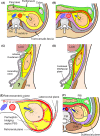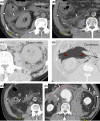The retroperitoneal interfascial planes: current overview and future perspectives
- PMID: 29123789
- PMCID: PMC5667245
- DOI: 10.1002/ams2.188
The retroperitoneal interfascial planes: current overview and future perspectives
Abstract
Recently, the concept of interfascial planes has become the prevalent theory among radiologists for understanding the retroperitoneal anatomy, having replaced the classic tricompartmental theory. However, it is a little known fact that the concept remains incomplete and includes embryological errors, which have been revised on the basis of our microscopic study. We believe that the concept not only provides a much clearer understanding of the retroperitoneal anatomy, but it also allows further development for diagnosis and treatment of retroperitoneal injuries and diseases, should it become an accomplished theory. We explain the history and outline of the concept of interfascial planes, correct common misunderstandings about the concept, explain the unconsciously applied therapeutic procedures based on the concept, and present future perspectives of the concept using our published and unpublished data. This knowledge could be essential to acute care physicians and surgeons sometime soon.
Keywords: Embryology; interfascial planes; retroperitoneum; sepsis/multiple organ failure; trauma.
Figures





Similar articles
-
Interfascial planes as surgical landmarks for laparoscopic upper retroperitoneal surgery: a cadaveric and retrospectively clinical study.Transl Androl Urol. 2024 May 31;13(5):720-735. doi: 10.21037/tau-23-632. Epub 2024 May 24. Transl Androl Urol. 2024. PMID: 38855604 Free PMC article.
-
Preliminary embryological study of the radiological concept of retroperitoneal interfascial planes: what are the interfascial planes?Surg Radiol Anat. 2014 Dec;36(10):1079-87. doi: 10.1007/s00276-014-1301-y. Epub 2014 May 10. Surg Radiol Anat. 2014. PMID: 24817559
-
Traumatic retroperitoneal hematoma spreads through the interfascial planes.J Trauma. 2005 Sep;59(3):595-607; discussion 607-8. J Trauma. 2005. PMID: 16361901
-
Retroperitoneal anatomy with the aid of pathologic fluid: An imaging pictorial review.J Clin Imaging Sci. 2023 Dec 13;13:36. doi: 10.25259/JCIS_79_2023. eCollection 2023. J Clin Imaging Sci. 2023. PMID: 38205277 Free PMC article. Review.
-
Primary retroperitoneal masses: what is the differential diagnosis?Abdom Imaging. 2015 Aug;40(6):1887-903. doi: 10.1007/s00261-014-0311-x. Abdom Imaging. 2015. PMID: 25468494 Review.
Cited by
-
Rare case of bilateral pleural effusion caused by pancreaticopleural fistula.BMJ Case Rep. 2020 Sep 7;13(9):e234286. doi: 10.1136/bcr-2020-234286. BMJ Case Rep. 2020. PMID: 32900718 Free PMC article.
-
Interfascial planes as surgical landmarks for laparoscopic upper retroperitoneal surgery: a cadaveric and retrospectively clinical study.Transl Androl Urol. 2024 May 31;13(5):720-735. doi: 10.21037/tau-23-632. Epub 2024 May 24. Transl Androl Urol. 2024. PMID: 38855604 Free PMC article.
-
Comprehensive treatment strategy for pancreaticopleural fistula: A rare case report and review of 91 cases.Medicine (Baltimore). 2025 Jan 3;104(1):e41184. doi: 10.1097/MD.0000000000041184. Medicine (Baltimore). 2025. PMID: 40184110 Free PMC article. Review.
-
Retroperitoneum revisited: a review of radiological literature and updated concept of retroperitoneal fascial anatomy with imaging features and correlating anatomy.Surg Radiol Anat. 2024 Aug;46(8):1165-1175. doi: 10.1007/s00276-024-03432-8. Epub 2024 Jul 4. Surg Radiol Anat. 2024. PMID: 38963431 Free PMC article. Review.
-
Comparison of surgical outcomes between robot-assisted and conventional laparoscopic nerve-sparing modified radical hysterectomy for deep endometriosis.Arch Gynecol Obstet. 2024 Sep;310(3):1677-1685. doi: 10.1007/s00404-024-07674-0. Epub 2024 Aug 16. Arch Gynecol Obstet. 2024. PMID: 39150505
References
-
- Ishikawa K, Nakao S, Murakami G et al Preliminary embryological study of the radiological concept of retroperitoneal interfascial planes: what are the interfascial planes? Surg. Radiol. Anat. 2014; 36: 1079–87. - PubMed
-
- Meyers MA, Whalen JP, Peelle K, Berne AS. Radiologic features of extraperitoneal effusions. An anatomic approach. Radiology 1972; 104: 249–57. - PubMed
-
- Meyers MA. The extraperitoneal spaces: normal and pathologic anatomy In: Meyers MA. (ed). Dynamic Radiology of the Abdomen: Normal and Pathologic Anatomy, 1st edn New York, NY: Springer‐Verlag, 1976; 113–94.
-
- Molmenti EP, Balfe DM, Kanterman RY, Bennett HF. Anatomy of the retroperitoneum: observations of the distribution of pathologic fluid collections. Radiology 1996; 200: 95–103. - PubMed
-
- Aizenstein RI, Wilbur AC, O'Neil HK. Interfascial and perinephric pathways in the spread of retroperitoneal disease: refined concepts based on CT observations. AJR Am. J. Roentgenol. 1997; 168: 639–43. - PubMed
Publication types
LinkOut - more resources
Full Text Sources
Other Literature Sources

